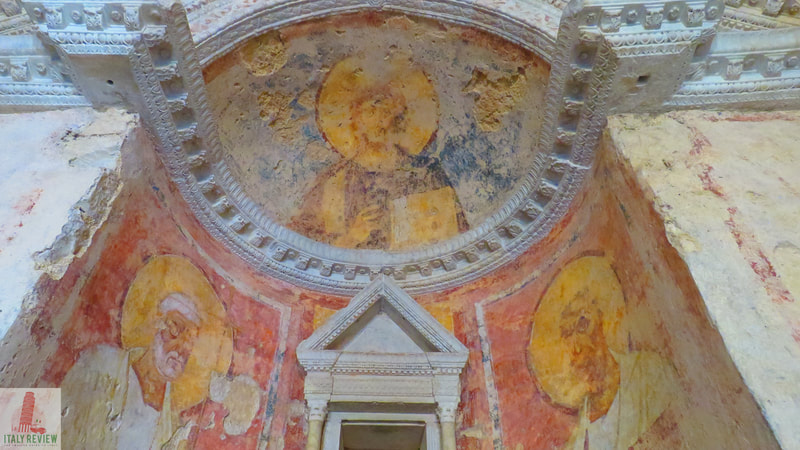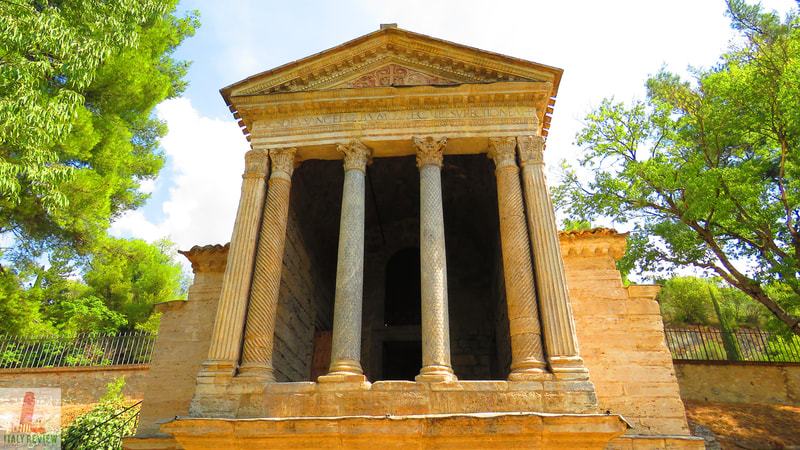Tempietto del Clitunno
|
By Dion Protani
|
Latest update: 9 January 2024
|
|
The Tempietto del Clitunno is situated within the Province of Perugia and was built between the 4th and 9th centuries AD. It's officially part of the Comune of Pissignano in the Umbria region.
Since 2011, it's been a UNESCO World Heritage Site, one of the structures under the heading of Longobards in Italy: Places of the Power (568-774 A.D.). |
The temple complex can be a little tricky to find; it looks simple enough on the Google map but that sometimes just leads you to the main road above it from which you can't gain access. From the main road there's a turn off for the correct, Via del Tempio.
Related links
Profile
The Tempietto del Clitunno, also known as the Temple of Clitumnus, is a small but beautiful ancient temple located in the Umbrian countryside, near the town of Campello sul Clitunno, in central Italy. It is one of the remarkable UNESCO World Heritage Sites in the region, recognized for its historical and artistic significance.
History
The Tempietto del Clitunno dates back to the 5th or 6th century AD and is believed to have been originally built as a Roman funerary monument or a small Christian church. Its precise historical context and original purpose remain a subject of scholarly debate.
The temple is dedicated to the river god Clitumnus, which flows nearby and has been an important water source in the region since ancient times. The temple's location and design reflect its close association with the natural surroundings and the reverence for the river.
The temple is dedicated to the river god Clitumnus, which flows nearby and has been an important water source in the region since ancient times. The temple's location and design reflect its close association with the natural surroundings and the reverence for the river.
Key features
The Tempietto del Clitunno is a small, elegant, and well-preserved structure with a rectangular plan, featuring a porch with four Corinthian columns at the front and two on each side. The columns support an entablature and a pediment, creating a harmonious and classical appearance. The temple is built of local limestone and topped with a tiled roof.
The simplicity and grace of the temple's design, combined with its picturesque setting, make it an inspiring example of ancient Roman and early Christian architecture.
The simplicity and grace of the temple's design, combined with its picturesque setting, make it an inspiring example of ancient Roman and early Christian architecture.
Visitor information
- Historical Significance: The temple is a symbol of the historical and cultural heritage of the region, connecting ancient Roman traditions and early Christian influences.
- Natural Setting: The temple is located in a serene and picturesque spot, near the clear waters of the Clitunno River, surrounded by lush vegetation.
- Artistic Inspiration: The temple has been admired and celebrated by artists, writers, and poets over the centuries for its aesthetic and evocative qualities.
- Cultural and Historical Context: The site offers an opportunity to learn about the ancient history and culture of Umbria and the religious practices of the region.
- Accessibility: The Tempietto del Clitunno is easily accessible by car from nearby towns such as Spoleto and Assisi.
- Photography Opportunities: The temple and its surroundings provide excellent photo opportunities for capturing the beauty of the site.
- Local Cuisine: Visitors can enjoy traditional Umbrian dishes at nearby restaurants, adding to the overall experience.
|
Opening-times
Tue - Sat: 08:15 - 19:15 Sundays: 14:15 - 19:15 Mondays: closed |
Prices
Adults: €2 Concessions: €1 (youths from 18-25) Under 18's/Over 65's: free entry |
Tempietto del Clitunno
|
Comune: Pissignano
Province: Perugia Region: Umbria Built: 4th - 9th century AD Architectural style: Paleochristian Close by: Campello sul Clitunno, Spoleto, Trevi, Foligno, Sellano Recommended hotel: Il Borgo dell'Ulivo (8 km) |
UNESCO World Heritage Site
Longobards in Italy: Places of the Power (568-774 A.D.)
Site: The Clitunno Tempietto
Year: 2011
Longobards in Italy: Places of the Power (568-774 A.D.)
Site: The Clitunno Tempietto
Year: 2011























